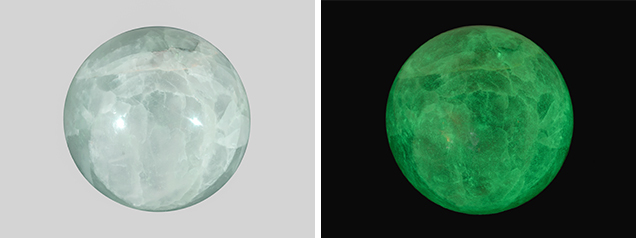Fluorite Sphere with Phosphorescent Coating

The sphere was warm to the touch. Microscopic examination revealed a colorless plastic coating, readily identifiable by the numerous trapped gas bubbles trapped within (figure 2, top). Upon further inspection, a subsurface granular material that contributed both a very subtle green component to the overall bodycolor of the sphere was also observed (figure 2, bottom). The granular material was also responsible for the material’s phosphorescence. It was apparent from these observations that the colorless coating was used to adhere the fine-grained powder to the surface of the sphere. The coating acted as an enhancement, contributing a near-vitreous luster to the finished sphere. The stone also contained numerous cleavage cracks oriented in numerous unrelated directions, and fractures along grain boundaries indicative of a crystalline aggregate material. Because the fine-grained powder was coated with polymer, we were unable to analyze it for identification; however, the appearance is consistent with that of a strontium aluminate material that has been previously reported to coat “night glowing pearls” (Spring 2005 Lab Notes, pp. 46–47).
Figure 2. Gas bubbles were trapped in the colorless plastic coating of this “night glowing pearl” (top) and a granular material underneath the colorless coating was the source of the phosphorescence (bottom). Photomicrographs by Nathan Renfro; field of view 3.55 mm.
Due to the plastic coating, a refractive index measurement of the substrate material was not possible. Raman spectroscopy positively identified the substrate material as fluorite, which was consistent with the microscopic appearance. While night glowing pearls have been previously reported, this example was particularly unique because of its large size and the fact that the phosphorescent reaction was easily induced by visible light. It was also unusual that the phosphorescent material was nearly invisible to the naked eye, creating the appearance of a normal, uncoated fluorite sphere.
.jpg)


